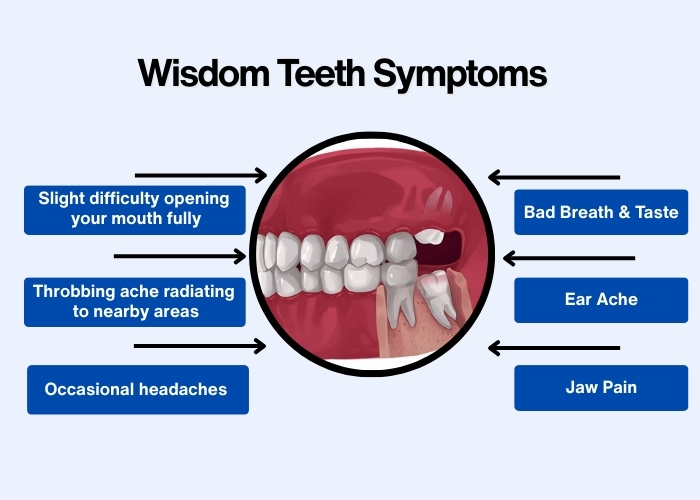
Most of us grow up hearing about the “dreaded” wisdom teeth, which have a reputation for making their grand entrance at the most inconvenient times and often causing discomfort and confusion. But when it’s your turn to deal with them, you may wonder: how long does the wisdom tooth takes to erupt?
If you’ve felt pressure in the back of your mouth or noticed slight swelling, you’re not alone.
Understanding the journey of wisdom teeth can help you feel more prepared and less anxious about what’s happening inside your mouth.
These teeth are a natural part of human development, yet everyone’s experience can differ wildly. Some people breeze through it with barely any symptoms, while others face swelling, discomfort, or even surgery.
In this blog, we’ll walk you through everything you need to know: what a wisdom tooth is, why we have them, when they appear, how long wisdom teeth take to grow, and first signs of wisdom teeth coming in. We’ll also cover whether they always need to be removed and what complications to look out for.
What Is A Wisdom Tooth?
A wisdom tooth is the third and final set of molars that usually appear in your late teens or early twenties. They’re located at the very back of your mouth, with one in each corner — upper right, upper left, lower right, and lower left.
Think of wisdom teeth as the “late bloomers” of your smile. While your other teeth show up during childhood, these molars typically wait until adulthood to make their grand entrance.
Interestingly, not everyone gets all four wisdom teeth. Some people may have fewer, and a lucky few might not develop any at all!
Why Do We Have Wisdom Teeth?
You might wonder why we have wisdom teeth at all if they often cause problems. The answer dates back to our ancestors.
Early humans had a more challenging diet — one that included raw plants, tough meat, and roots, which required greater chewing power. Wisdom teeth acted like nature’s backup plan, giving extra help once the earlier teeth wore down.
Today, with our softer, cooked foods and modern dental care, we don’t really need them. Our jaws have also become smaller over time, leaving less room for these latecomers. That mismatch often leads to issues like crowding, impaction, or infection.
In short, wisdom teeth are a leftover from a past era — useful once, but now often more troublesome than helpful.
What Age Do Wisdom Teeth Come In?
Wisdom teeth typically begin to develop in the jawbone during the pre-teen years, but usually don’t break through the gums until between 17 and 25 years old. However, timing can vary greatly. Some people might notice the first signs of wisdom teeth coming in as early as 16, while others don’t experience any movement until their late twenties.
In rare cases, wisdom teeth can remain dormant for life without ever emerging. Genetics, jaw size, and individual dental development all play a role in this timeline.
How Long Does The Wisdom Tooth Take To Erupt Through The Gum?
Once a wisdom tooth starts to push through, the process can take several weeks to several months. In some cases, it may even take years for the tooth to emerge fully.
Here’s a general timeline to give you a rough idea:
- Initial pressure and soreness: A few weeks
- Partial eruption: 1 to 6 months
- Complete eruption: Up to a year (sometimes longer)
Factors such as jaw space, tooth alignment, and whether the tooth is impacted can significantly affect how long wisdom teeth take to erupt through the gums.
For example, if there is limited space, a tooth might emerge only partially and become partially trapped, leading to discomfort and potential infections.
Signs That Your Wisdom Teeth Are Coming In
Recognizing the first signs of wisdom teeth emerging can help you take action early and avoid potential complications. Here’s what you might notice:
- Tenderness or swelling in the gums at the back of your mouth
- Jaw stiffness or slight difficulty opening your mouth fully
- A dull, throbbing ache radiating to nearby areas
- Occasional headaches or earaches
- An odd taste if an emerging tooth creates small gum pockets, trapping food and bacteria
Imagine trying to squeeze into an overcrowded elevator — there’s going to be some pushing and bumping. Your wisdom teeth behave similarly when trying to fit into a mouth that is already crowded.

Signs That Your Wisdom Teeth Are About To Come In
To dive deeper, here are specific signs your wisdom teeth may be just around the corner:
- Red or inflamed gums: Your gums may look puffy or red around the eruption site.
- Gum bleeding: When brushing or flossing, you might notice bleeding near the back of your mouth.
- Small cuts or sores: Sometimes the gum tissue breaks slightly as the tooth emerges.
- Sensation of pressure: It feels like something is pushing from within your gums.
- Partial visibility: You might even see a white speck poking through the gum.
If any of these symptoms persist for more than a week or worsen, it’s wise to book a dental appointment to assess the situation.
How Is A Wisdom Tooth Removed?
When wisdom teeth cause pain, crowding, or infection, removal is often recommended. The procedure typically follows these steps:
- Consultation: X-rays help your dentist evaluate the position of your teeth.
- Anesthesia: Local anesthesia numbs the area, or general anesthesia may be used for complex cases.
- Extraction:
- Simple Extraction: If the tooth has fully erupted, it can be easily pulled out.
- Surgical Extraction: If the tooth is impacted, the dentist makes a small incision in your gum and may remove the tooth in sections.
- Simple Extraction: If the tooth has fully erupted, it can be easily pulled out.
A real-world example? Think of it like removing a splinter. Sometimes it slides right out, but if it’s deeply buried, you need careful, skilled work to remove it safely.
Recovery typically takes about a week, and following post-op care instructions is key to healing well.
Do All Wisdom Teeth Need To Be Removed?
No, not all wisdom teeth require removal. If your wisdom teeth:
- Are healthy
- Fully erupted
- Aligned adequately with the opposing teeth
- Easily cleaned during daily hygiene
— Then you can likely keep them!
Routine monitoring through dental checkups ensures they remain trouble-free. Your dentist will assess your wisdom teeth regularly and recommend removal only if necessary.
Impacted Wisdom Tooth Complications
Impacted wisdom teeth occur when they don’t have enough room to emerge or develop normally. They can lead to several complications, including:
- Infections: Bacteria can get trapped around a partially erupted tooth.
- Cysts: Fluid-filled sacs can form around the impacted tooth.
- Damage to nearby teeth: Impacted wisdom teeth may push against other molars.
- Gum disease: Difficulty cleaning the area increases your risk.
- Tooth decay: Partially emerged teeth are harder to brush and floss properly.
Imagine hosting a party and not having enough seats — chaos ensues. The same concept applies inside your mouth when there’s no space for new teeth.
Final Thoughts
Wisdom teeth are a fascinating, if sometimes frustrating, part of our dental journey. So, how long does it take for wisdom teeth to come in? While the answer varies, it generally spans from a few months to a year or more, depending on your unique circumstances.
Paying attention to the first signs of wisdom teeth emerging, such as tenderness, pressure, or visible growth, allows you to plan.
Whether it’s smooth sailing or requires a bit of intervention, knowing what’s normal and when to seek help can make a big difference.
If you’re noticing unusual pressure, swelling, or discomfort in your mouth, it’s a good idea to schedule a dental checkup. Early evaluation ensures that you catch any issues before they become serious. Your dentist can guide you through monitoring or removing wisdom teeth as needed, always prioritizing your comfort and health.


